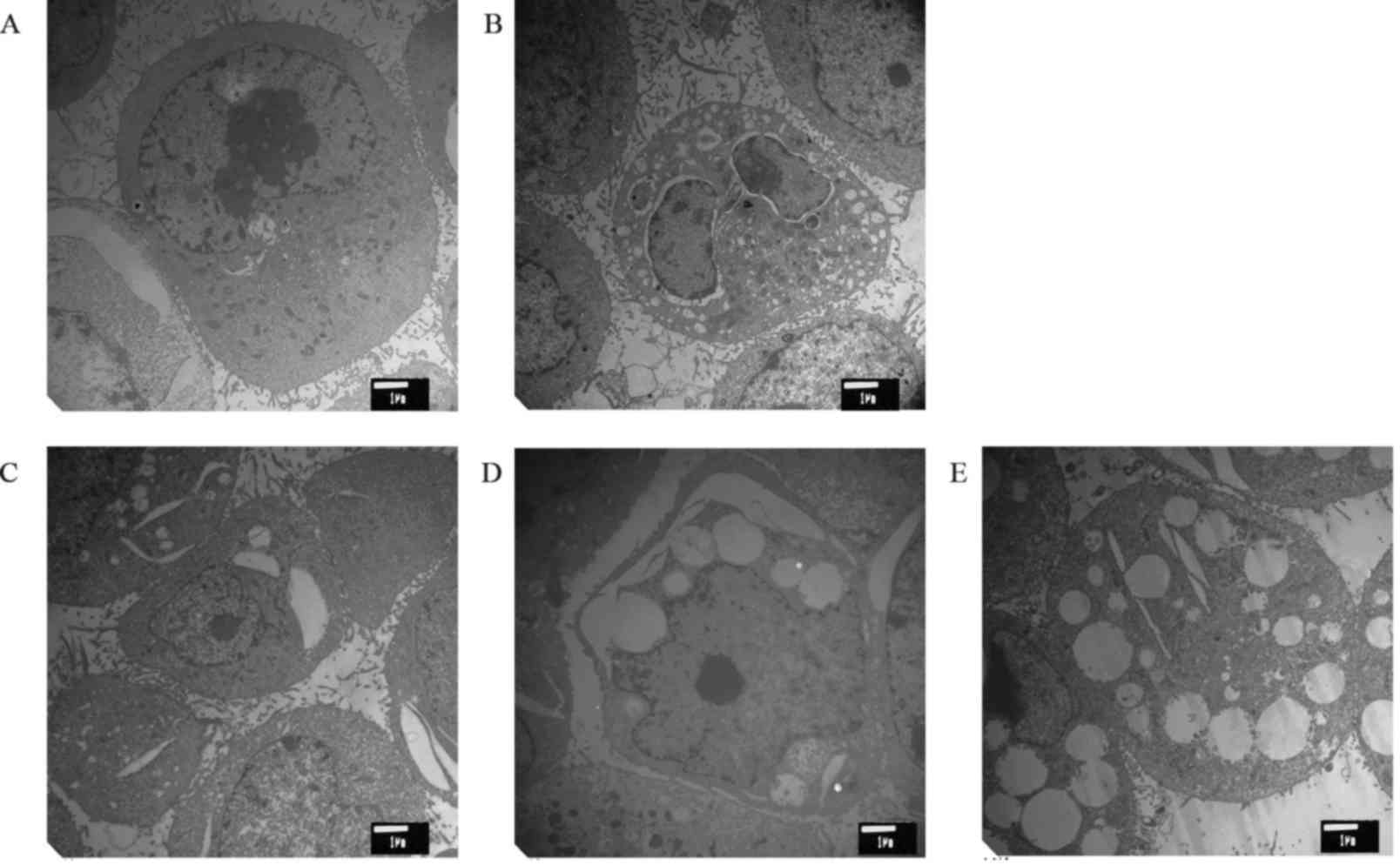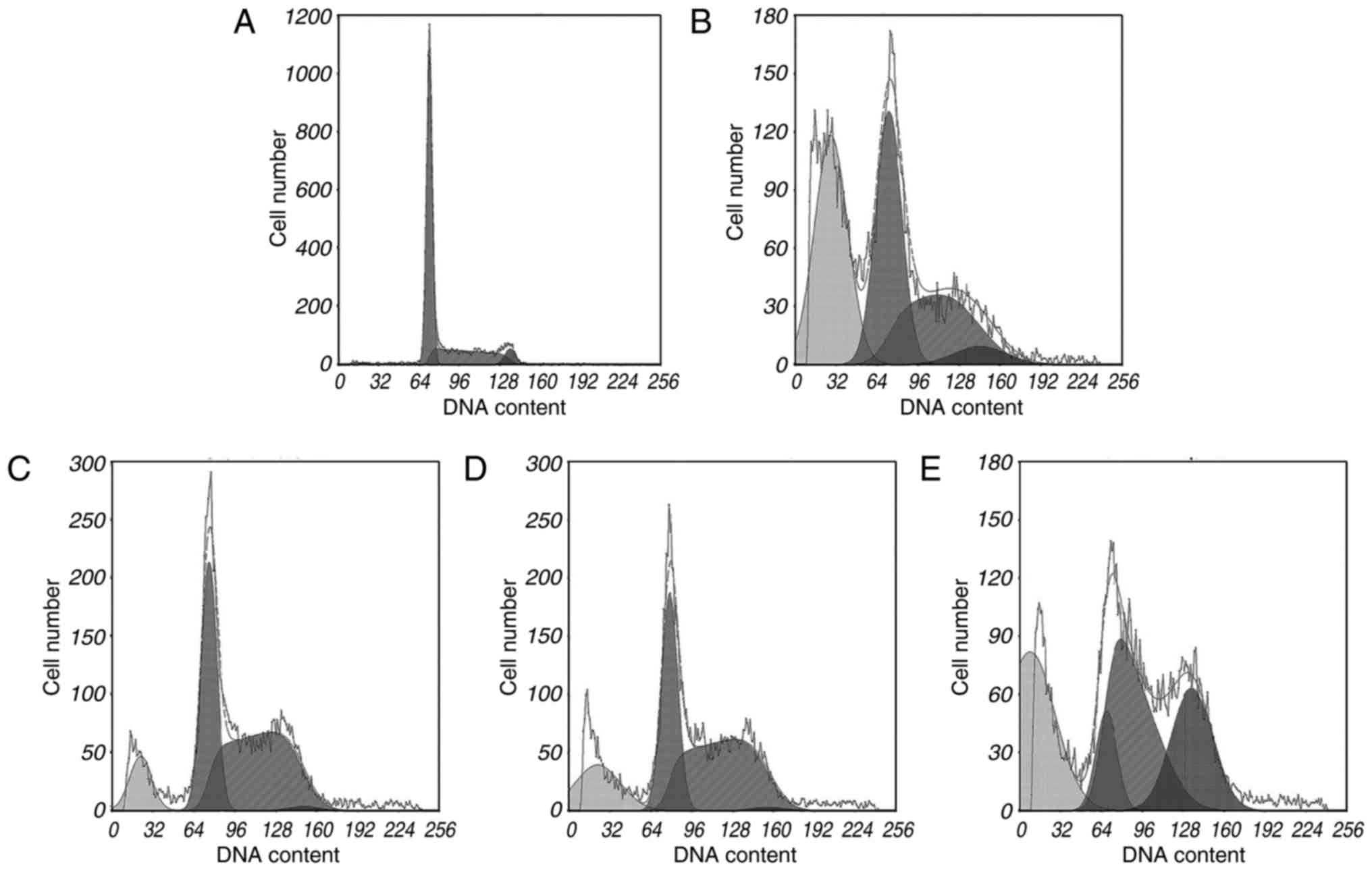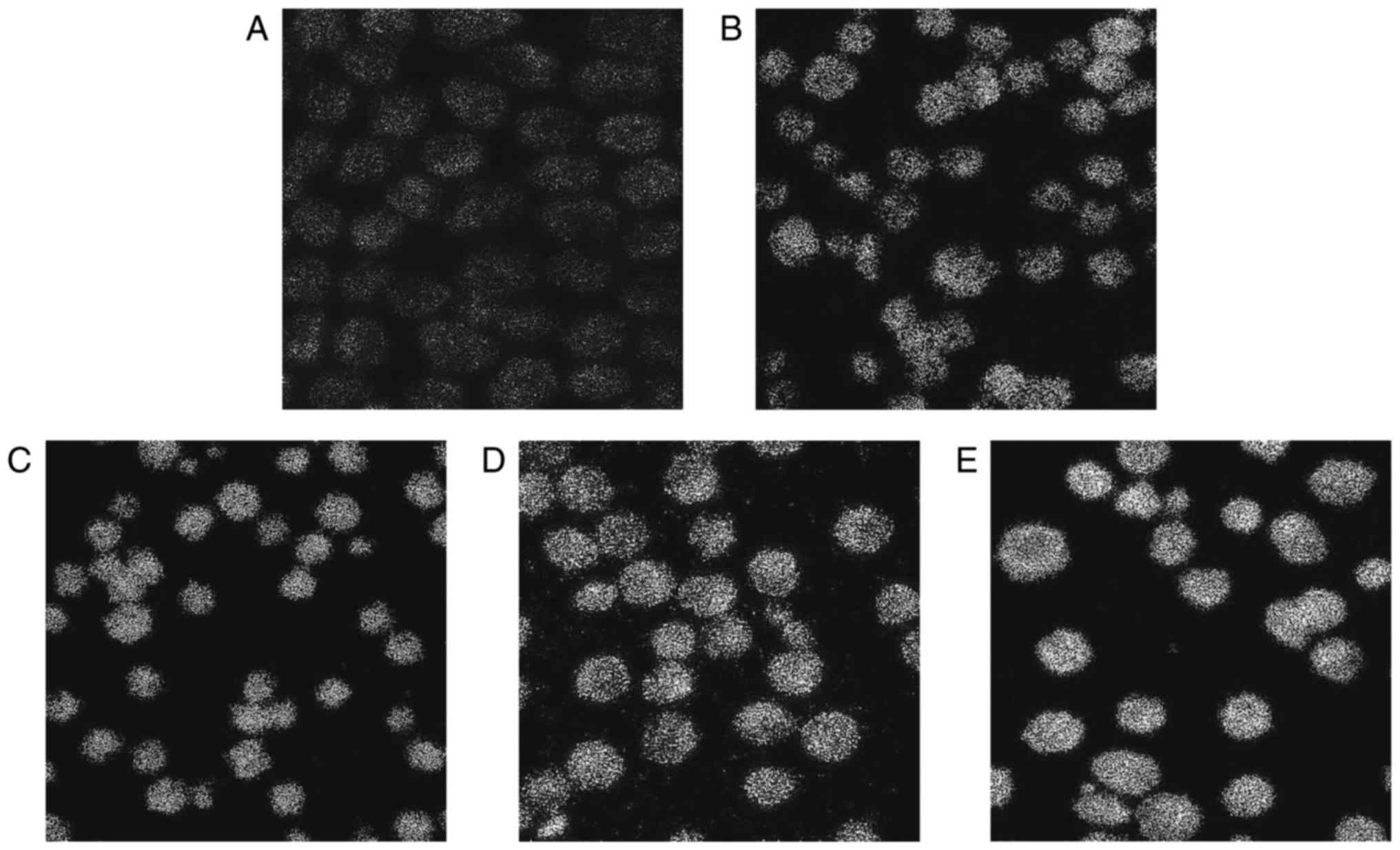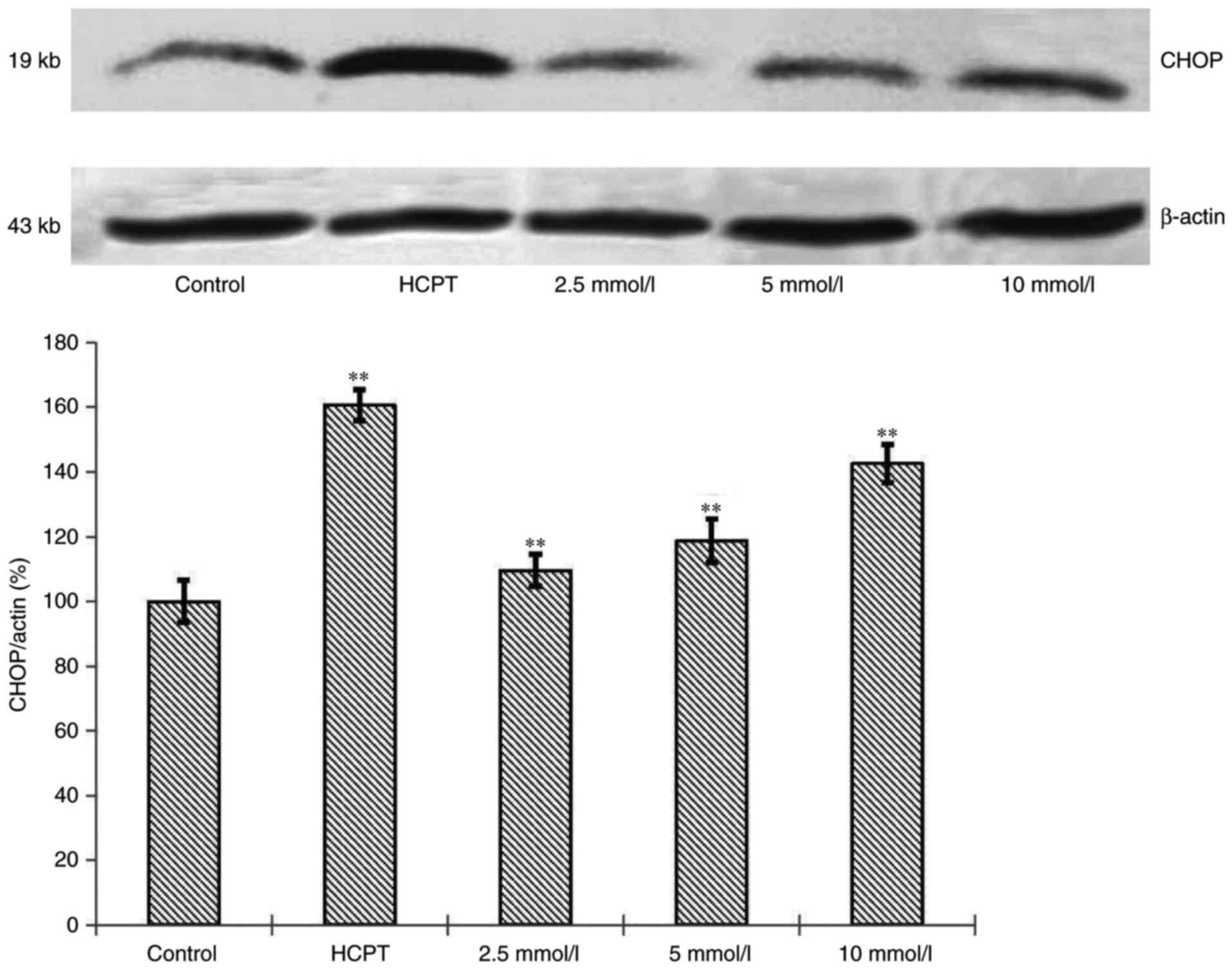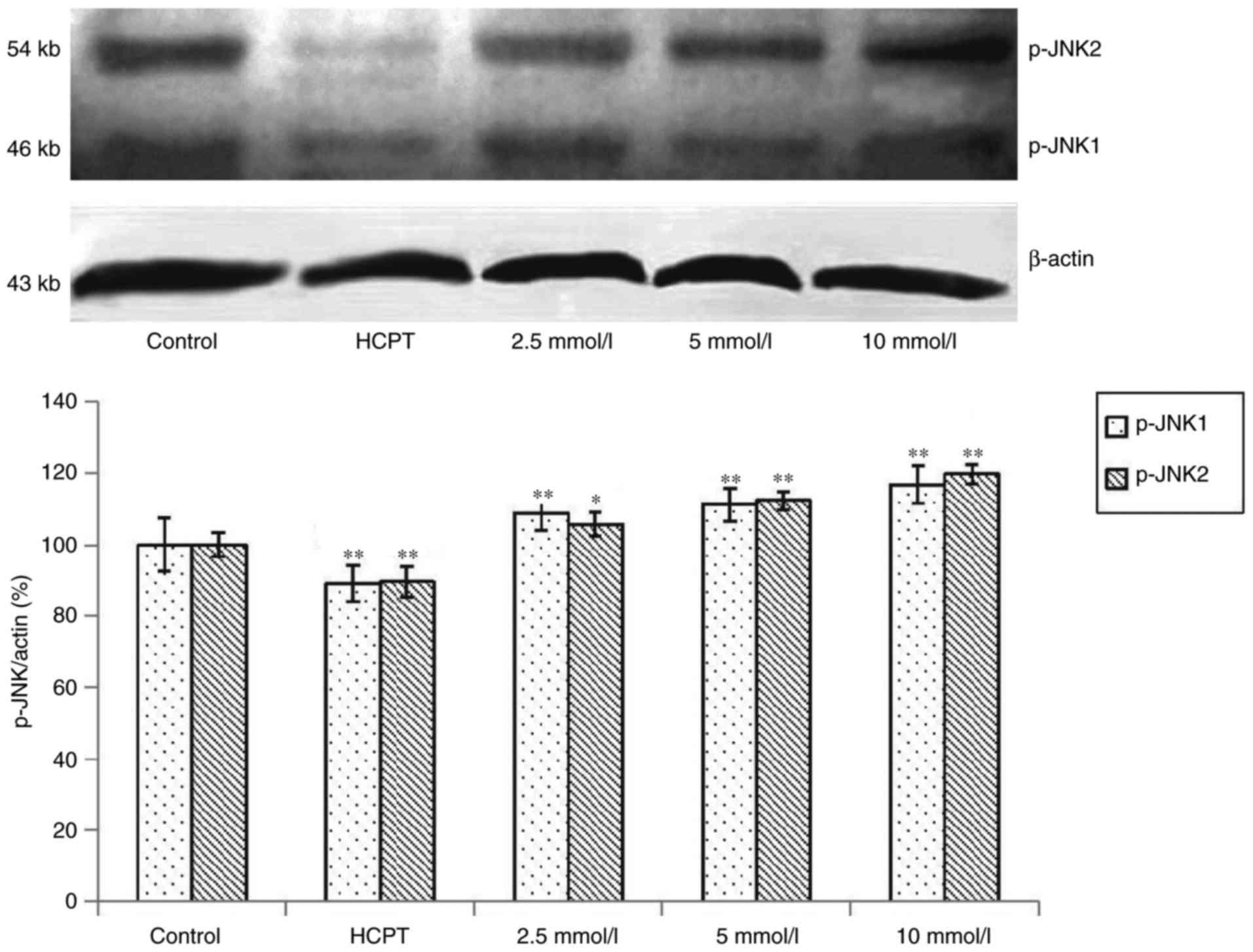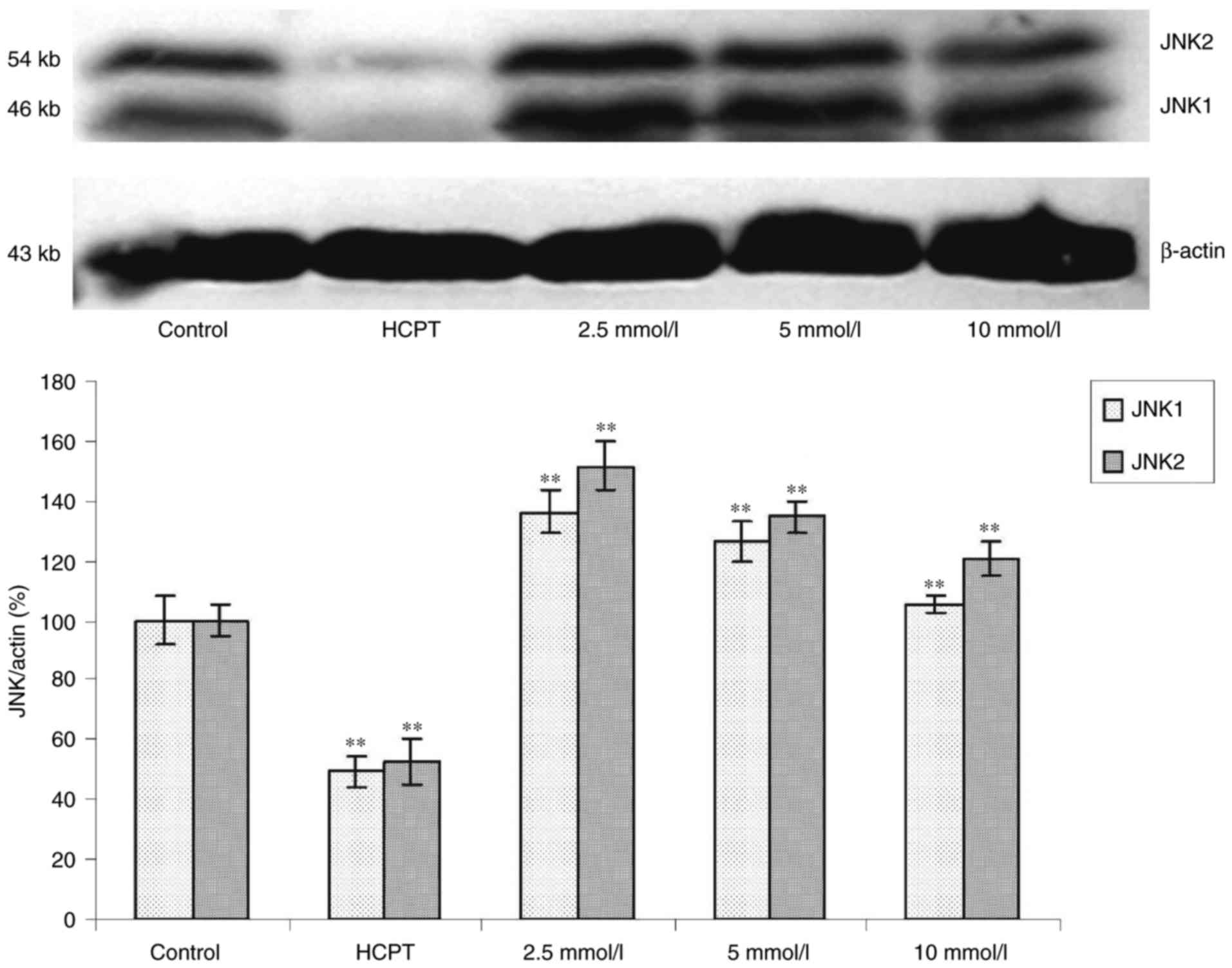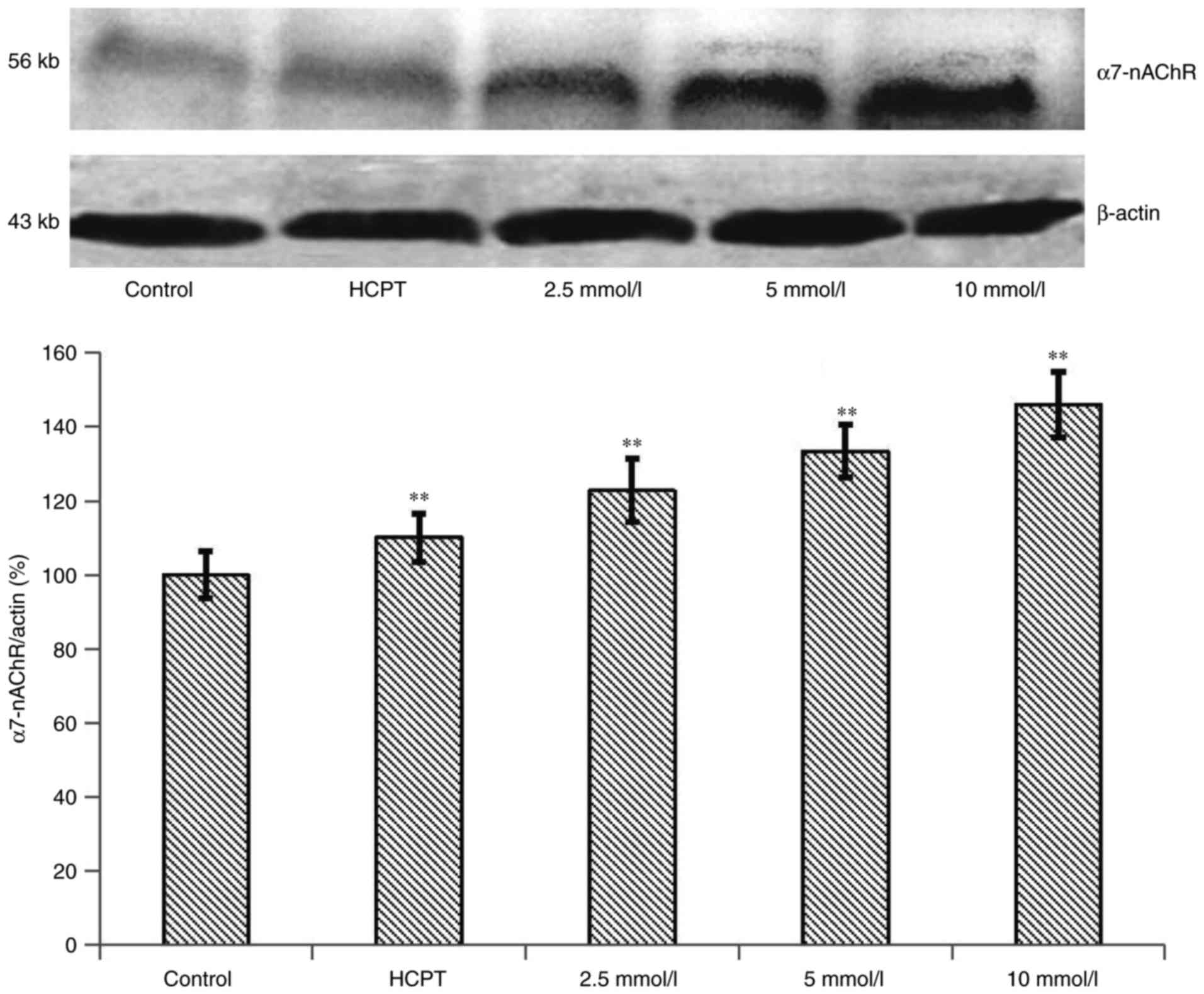|
1
|
Zhang PP, Wang PQ, Qiao CP, Zhang Q, Zhang
JP, Chen F, Zhang X, Xie WF, Yuan ZL, Li ZS and Chen YX:
Differentiation therapy of hepatocellular carcinoma by inhibiting
the activity of AKT/GSK-3β/β-catenin axis and TGF-β induced EMT
with sophocarpine. Cancer Lett. 376:95–103. 2016. View Article : Google Scholar : PubMed/NCBI
|
|
2
|
Liang L, Wang XY, Zhang XH, Ji B, Yan HC,
Deng HZ and Wu XR: Sophoridine exerts an anti-colorectal carcinoma
effect through apoptosis induction in vitro and in vivo. Life Sci.
91:1295–1303. 2012. View Article : Google Scholar : PubMed/NCBI
|
|
3
|
Li YJ, Yang Q, Zhang K, Guo YY, Li XB,
Yang L, Zhao MG and Wu YM: Cytisine confers neuronal protection
against excitotoxic injury by down-regulating GluN2B-containing
NMDA receptors. Neurtoxicology. 34:219–225. 2013. View Article : Google Scholar
|
|
4
|
Lin Z, Huang CF, Liu XS and Jiang J: In
vitro anti-tumour activities of quinolizidine alkaloids derived
from Sophora flavescens Ait. Basic Clin Pharmacolo Toxicol.
108:304–309. 2011. View Article : Google Scholar
|
|
5
|
Malhi H and Kaufman RJ: Endoplasmic
reticulum stress in liver disease. J Hepatol. 54:795–809. 2011.
View Article : Google Scholar : PubMed/NCBI
|
|
6
|
Lenna S and Trojanowska M: The role of
endoplasmic reticulum stress and the unfolded protein response in
fibrosis. Curr Opin Rheumatol. 24:2012. View Article : Google Scholar : PubMed/NCBI
|
|
7
|
Friedman SL: Mac the knife?
Macrophages-the double-edged sword of hepatic fibrosis. J Clin
Invest. 115:29–32. 2005. View Article : Google Scholar : PubMed/NCBI
|
|
8
|
Tabas I and Ron D: Integrating the
mechanisms of apoptosis induced by endoplasmic reticulum stress.
Nat Cell Biol. 13:184–190. 2011. View Article : Google Scholar : PubMed/NCBI
|
|
9
|
Urra H, Dufey E, Lisbona F, Rojas-Rivera D
and Hetz C: When ER stress reaches a dead end. Biochim Biophys
Acta. 1833:3507–3517. 2013. View Article : Google Scholar : PubMed/NCBI
|
|
10
|
Farrukh MR, Nissar UA, Afnan Q, Rafiq RA,
Sharma L, Amin S, Kaiser P, Sharma PR and Tasduq SA: Oxidative
stress mediated Ca2+ release manifests endoplasmic
reticulum stress leading to unfolded protein response in UV-B
irradiated human skin cells. J Dermatol Sci. 75:24–35. 2014.
View Article : Google Scholar : PubMed/NCBI
|
|
11
|
Zhu M, Zhou S, Huang Z, Wen J and Li H:
Ca2+-dependent endoplasmic reticulum stress regulates
mechanical stress regulates mechanical stress-mediated cartilage
thinning. J Dent Res. 95:889–896. 2016. View Article : Google Scholar : PubMed/NCBI
|
|
12
|
Biagioli M, Pifferi S, Ragghianti M, Bucci
S, Rizzuto R and Pinton P: Endoplasmic reticulum stress and
alteration in calcium homeostasis are involved in cadmium-induced
apoptpsis. Cell Calcium. 43:184–195. 2007. View Article : Google Scholar : PubMed/NCBI
|
|
13
|
Wan S and Jiang L: Endoplasmic reticulum
(ER) stress and the unfolded protein response (UPR) in plants.
Protoplasma. 253:753–764. 2016. View Article : Google Scholar : PubMed/NCBI
|
|
14
|
Li K, Zhang L, Xiang X, Gong S, Ma L, Xu
L, Wang G, Liu Y, Ji X, Liu S, et al: Arsenic trioxide alleviates
airway hyperresponsiveness and promotes apoptosis of
CD4+ T lymphocytes: Evidence for involvement of the ER
stress-CHOP pathway. Ir J Med Sci. 182:573–583. 2013. View Article : Google Scholar : PubMed/NCBI
|
|
15
|
Li J and Holbrook NJ: Elevated
gadd153/chop expression and enhanced c-Jun N-terminal protein
kinase activation sensitizes aged cells to ER stress. Exp Gerontol.
39:735–744. 2004. View Article : Google Scholar : PubMed/NCBI
|
|
16
|
Momoi T: Caspases involved in ER
stress-mediated cell death. J Chem Neuroanat. 28:101–105. 2004.
View Article : Google Scholar : PubMed/NCBI
|
|
17
|
Zhang Q, Liu J, Chen S, Liu J, Liu L, Liu
G, Wang F, Jiang W, Zhang C, Wang S and Yuan X: Caspase-12 is
involved in stretch-induced apoptosis mediated endoplasmic
reticulum stress. Apoptosis. 21:432–442. 2016. View Article : Google Scholar : PubMed/NCBI
|
|
18
|
Hetz C, Russelakis-Carneiro M, Maundrell
K, Castilla J and Soto C: Caspase-12 and endoplasmic reticulum
stress mediate neurotoxicity of pathological prion protein. EMBO J.
22:5435–5445. 2003. View Article : Google Scholar : PubMed/NCBI
|
|
19
|
Hitomi J, Katayama T, Eguchi Y, Kudo T,
Taniguchi M, Koyama Y, Manabe T, Yamagishi S, Bando Y, Imaizumi K,
et al: Involvement of caspase-4 in endoplasmic reticulum
stress-induced apoptosis and Abeta-induced cell death. J Cell Biol.
165:347–356. 2004. View Article : Google Scholar : PubMed/NCBI
|
|
20
|
Walker N, Howe C, Glover M, McRobbie H,
Barnes J, Nosa V, Parag V, Bassett B and Bullen C: Cytisine versus
nicotine for smoking cessation. N Engl J Med. 371:2353–2362. 2014.
View Article : Google Scholar : PubMed/NCBI
|
|
21
|
Ponzoni L, Braida D, Pucci L, Andrea D,
Fasoli F, Manfredi I, Papke RL, Stokes C, Cannazza G, Clementi F,
et al: The cytisine derivatives, CC4 and CC26, reduce
nicotine-induced conditioned place preference in zebrafish by
acting on heteromeric neuronal nicotinic acetylcholine receptors.
Psychopharmacology. 231:4681–4693. 2014. View Article : Google Scholar : PubMed/NCBI
|
|
22
|
Radchenko EV, Dravolina OA and Bespalov
AY: Agonist and antagonist effects of cytisine in vivo.
Neuropharmacology. 95:206–214. 2015. View Article : Google Scholar : PubMed/NCBI
|
|
23
|
Wessler I and Kirkpatrick CJ:
Acetylcholine beyond neurons: The non-neuronal cholinergic system
in humans. Br J Pharmacol. 154:1558–1571. 2008. View Article : Google Scholar : PubMed/NCBI
|
|
24
|
Séguéla P, Wadiche J, Dineley-Miller K,
Dani JA and Patrick JW: Molecular cloning, functional properties,
and distribution of rat brain alpha 7: A nicotinic cation channel
highly permeable to calcium. J Neurosci. 13:596–604.
1993.PubMed/NCBI
|
|
25
|
Guerra-Álvarez M, Moreno-Ortega AJ,
Navarro E, Fernández-Morales JC, Egea J, López MG and Cano-Abad MF:
Positive allosteric modulation of alpha-7 nicotinic receptors
promotes cell death by inducing Ca2+ release from the
endoplasmic reticulum. J Neurochem. 133:309–319. 2015. View Article : Google Scholar : PubMed/NCBI
|
|
26
|
Levine DS, Rubin CE, Reid BJ and Haggitt
RC: Specialized metaplastic columnar epithelium in Barrett's
esophagus. A comparative transmission electron microscopic study.
Lab Invest. 60:418–432. 1989.PubMed/NCBI
|
|
27
|
Kawamoto K, Kawakami K, Kawamura Y,
Matsumura H and Ohyama A: New sensitivity test using flow cytomety.
J Neurooncol. 6:361–370. 1988. View Article : Google Scholar : PubMed/NCBI
|
|
28
|
Lev-Ram V and Ellisman MH: Axonal
activation-induced calcium transients in myelinating Schwann cells,
cells, andmechanisms. J Neurosci. 15:2628–2637. 1995.PubMed/NCBI
|
|
29
|
Towbin H, Staehelin T and Gordon J:
Electrophoretic transfer of proteins from polyacrylamide gels to
nitrocellulose sheets: Procedure and some applications. Proc Natl
Acad Sci USA. 76:pp. 4350–4354. 1979; View Article : Google Scholar : PubMed/NCBI
|
|
30
|
Burnette WN: ‘Western blotting’:
Electrophoretic transfer of proteins from sodium dodecyl
sulfate-polyacrylamide gels to unmodified nitrocellulose and
radiographic detection with antibody and radioiodinated protein A.
Anal Biochem. 112:195–203. 1981. View Article : Google Scholar : PubMed/NCBI
|
|
31
|
Yu L, Wang X, Chen ZF, Jing B, Shang DY,
Sun YX, Yang JH, Zhang LF and Ji YB: Cytisine induces apoptosis of
HepG2 cells. Mol Med Rep. 16:3363–3370. 2017. View Article : Google Scholar : PubMed/NCBI
|
|
32
|
Winter E, Chiaradia LD, Silva AH, Nunes
RJ, Yunes RA and Creczynski-Pasa TB: Involvement of extrinsic and
intrinsic apoptotic pathways together with endoplasmic reticulum
stress in cell death induced by naphthylchalcones in a leukemic
cell line: Advantages of multi-target action. Toxicol In Vitro.
28:769–777. 2014. View Article : Google Scholar : PubMed/NCBI
|
|
33
|
Kawaguchi T, Miyazawa K, Moriya S, Ohtomo
T, Che XF, Naito M, Itoh M and Tomoda A: Combined treatment with
bortezomib plus bafilomycin A enhances the cytocidal effect and
induces endoplasmic reticulum stress in U266 myeloma cells:
Crosstalk among proteasome, autophagy-lysosome and ER stress. Int J
Oncol. 38:643–654. 2011.PubMed/NCBI
|
|
34
|
Zhu J, Chen M, Chen N, Ma A, Zhu C, Zhao
R, Jiang M, Zhou J, Ye L, Fu H and Zhang X: Glycyrrhetinic acid
induces G1-phase cell cycle arrest in human non-small cell lung
cancer cells through endoplasmic reticulum stress pathway. Int J
Oncol. 46:981–988. 2015. View Article : Google Scholar : PubMed/NCBI
|
|
35
|
Isomura M, Kotake Y, Masuda K, Miyara M,
Okuda K, Samizo S, Sanoh S, Hosoi T, Ozawa K and Ohta S:
Tributyltin-induced endoplasmic reticulum stress and its
Ca2+-mediated mechanism. Toxicol Appl Pharmacol.
272:137–146. 2013. View Article : Google Scholar : PubMed/NCBI
|
|
36
|
Nyberg WA and Espinosa A: Imiquimod
induces ER stress and Ca2+ influx independently of TLR7
and TLR8. Biochem Biophysl Res Commun. 473:789–794. 2016.
View Article : Google Scholar
|
|
37
|
Kaufman RJ and Malhotra JD: Calcium
trafficking integrates endoplasmic reticulum function with
mitochondrial bioenergetics. Biochim Biophys Acta. 1843:2233–2239.
2014. View Article : Google Scholar : PubMed/NCBI
|
|
38
|
Ahn C, An BS and Jeung EB: Streptozotocin
induces endoplasmic reticulum stress and apoptosis via disruption
of calcium homeostasis in mouse pancreas. Mol Cell Endocrinol.
412:302–308. 2015. View Article : Google Scholar : PubMed/NCBI
|
|
39
|
Verkhratsky A and Toescu EC: Endoplasmic
reticulum Ca2+ homeostasis and neuronal death. J Cell
Mol Med. 7:351–361. 2003. View Article : Google Scholar : PubMed/NCBI
|
|
40
|
Song YF, Luo Z, Zhang LH, Hogstrand C and
Pan YX: Endoplasmic reticulum stress and disturbed calcium
homeostasis are involved in copper-induced alteration in hepatic
lipid metabolism in yellow cafish Pelteobagrus fulvidraco.
Chemosphere. 144:2443–2453. 2016. View Article : Google Scholar : PubMed/NCBI
|
|
41
|
Ermak G and Davies KJ: Calcium and
oxidative stress: From cell signaling to cell death. Mol Immunol.
38:713–721. 2001. View Article : Google Scholar
|
|
42
|
Sun DP, Li XX, Liu XL, Zhao D, Qiu FQ, Li
Y and Ma P: Gypenosides induce apoptosis by Ca2+
overload mediated by endoplasmic-reticulum and store-operated
Ca2+ channels in human hepatoma cells. Cancer Biother
Radiopharm. 28:320–326. 2013. View Article : Google Scholar : PubMed/NCBI
|
|
43
|
Sciamanna MA, Griesmann GE, Williams CL
and Lennon VA: Nicotinic acetylcholine receptors of muscle and
neuronal (alpha7) types coexpressed in a small cell lung carcinoma.
J Neurochem. 69:2302–2311. 1997. View Article : Google Scholar : PubMed/NCBI
|
|
44
|
Lakshmanan AP, Thandavarayan RA,
Palaniyandi SS, Sari FR, Meilei H, Giridharan VV, Soetikno V,
Suzuki K, Kodama M and Watanabe K: Modulation of
AT-1R/CHOP-JNK-Caspase12 pathway by olmesartan treatment attenuates
ER stress-induced renal apoptosis in streptozotocin-induced
diabetic mice. Eur J Pharm Sci. 44:627–634. 2011.PubMed/NCBI
|
|
45
|
Huang Y, Li X, Wang Y, Wang H, Huang C and
Li J: Endoplasmic reticulum stress-induced hepatic stellate cell
apoptosis through calcium-mediated JNK/P38 MAPK and
calpain/caspase-12 pathways. Mol Cell Biochem. 394:1–12. 2014.
View Article : Google Scholar : PubMed/NCBI
|
|
46
|
Rao RV, Castro-Obregon S, Frankowski H,
Schuler M, Stoka V, del Rio G, Bredesen DE and Ellerby HM: Coupling
endoplasmic reticulum stress to the cell death program. An
Apaf-1-independent intrinsic pathway. J Biol Chem. 277:21836–21842.
2002. View Article : Google Scholar : PubMed/NCBI
|
|
47
|
Chow SE, Kao CH, Liu YT, Cheng ML, Yang
YW, Huang YK, Hsu CC and Wang JS: Resveratrol induced ER expansion
and ER caspase-mediated apoptosis in human nasopharyngeal carcinoma
cells. Apoptosis. 19:527–541. 2014. View Article : Google Scholar : PubMed/NCBI
|
|
48
|
Nakagawa T, Zhu H, Morishima N, Li E, Xu
J, Yankner BA and Yuan J: Caspase-12 mediates
endoplasmic-reticulum-specific apoptosis and cytotoxicity by
amyloid-beta. Nature. 403:98–103. 2000. View Article : Google Scholar : PubMed/NCBI
|
|
49
|
Fischer H, Koenig U, Eckhart L and
Tschachler E: Human caspase 12 has acquired deleterious mutations.
Biochem Biophys Res Commun. 293:722–726. 2002. View Article : Google Scholar : PubMed/NCBI
|
|
50
|
Oyadomari S and Mori M: Roles of
CHOP/GADD153 in endoplasmic reticulum stress. Cell Death Differ.
11:381–389. 2004. View Article : Google Scholar : PubMed/NCBI
|
|
51
|
Komatsu S, Miyazawa K, Moriya S, Takase A,
Naito M, Inazu M, Kohno N, Itoh M and Tomoda A: Clarithromycin
enhances bortezomib-induced cytotoxicity via endoplasmic reticulum
stress-mediated CHOP (GADD153) induction and autophagy in breast
cancer cells. Int J Oncol. 40:1029–1039. 2012. View Article : Google Scholar : PubMed/NCBI
|
|
52
|
Wang SF, Yen JC, Yin PH, Chi CW and Lee
HC: Involvement of oxidative stress-activated JNK signaling in the
methamphetamine-induced cell death of human SH-SY5Y cells.
Toxicology. 246:234–241. 2008. View Article : Google Scholar : PubMed/NCBI
|
|
53
|
Junttila MR, Li SP and Westermarck J:
Phosphatase-mediated crosstalk between MAPK signaling pathways in
the regulation of cell survival. FASEB J. 22:954–965. 2008.
View Article : Google Scholar : PubMed/NCBI
|
|
54
|
Rius B, López-Vicario C, González-Périz A,
Morán-Salvador E, García-Alonso V, Clária J and Titos E: Resolution
of inflammation in obesity-induced liver disease. Front Immunol.
3:2572012. View Article : Google Scholar : PubMed/NCBI
|
|
55
|
Du K, Takahashi T, Kuge S, Naganuma A and
Hwang GW: FBVO6 attenuates cadmium toxicity in HEK293 cells by
inhibiting ER stress and JNK activation. J Toxicol Sci. 39:861–866.
2014. View Article : Google Scholar : PubMed/NCBI
|
|
56
|
Bierut LJ: Nicotine dependence and genetic
variation in the nicotinic receptors. Drug Alcohol Depend. 104
Suppl 1:S64–S69. 2009. View Article : Google Scholar : PubMed/NCBI
|
|
57
|
Catassi A, Servent D, Paleari L, Cesario A
and Russo P: Multiple roles of nicotine on cell proliferation and
inhibition of apoptosis: Implications on lung carcinogenesis. Mutat
Res. 659:221–231. 2008. View Article : Google Scholar : PubMed/NCBI
|
|
58
|
Hecht SS: Tobacco carcinogens, their
biomarkers and tobacco-induced cancer. Nat Rev Cancer. 3:733–744.
2003. View Article : Google Scholar : PubMed/NCBI
|
|
59
|
Ng MK, Wu J, Chang E, Wang BY,
Katzenberg-Clark R, Ishii-Watabe A and Cooke JP: A central role for
nicotinic cholinergic regulation of growth factor-induced
endothelial cell migration. Arterioscler Thromb Vasc Biol.
27:106–112. 2007. View Article : Google Scholar : PubMed/NCBI
|
|
60
|
del Barrio L, Egea J, León R, Romero A,
Ruiz A, Montero M, Alvarez J and López MG: Calcium signalling
mediated through α7 and non-α7 nAChR stimulation is differentially
regulated in bovine chromaffin cells to induce catecholamine
release. Br J Pharmacol. 162:94–110. 2011. View Article : Google Scholar : PubMed/NCBI
|















